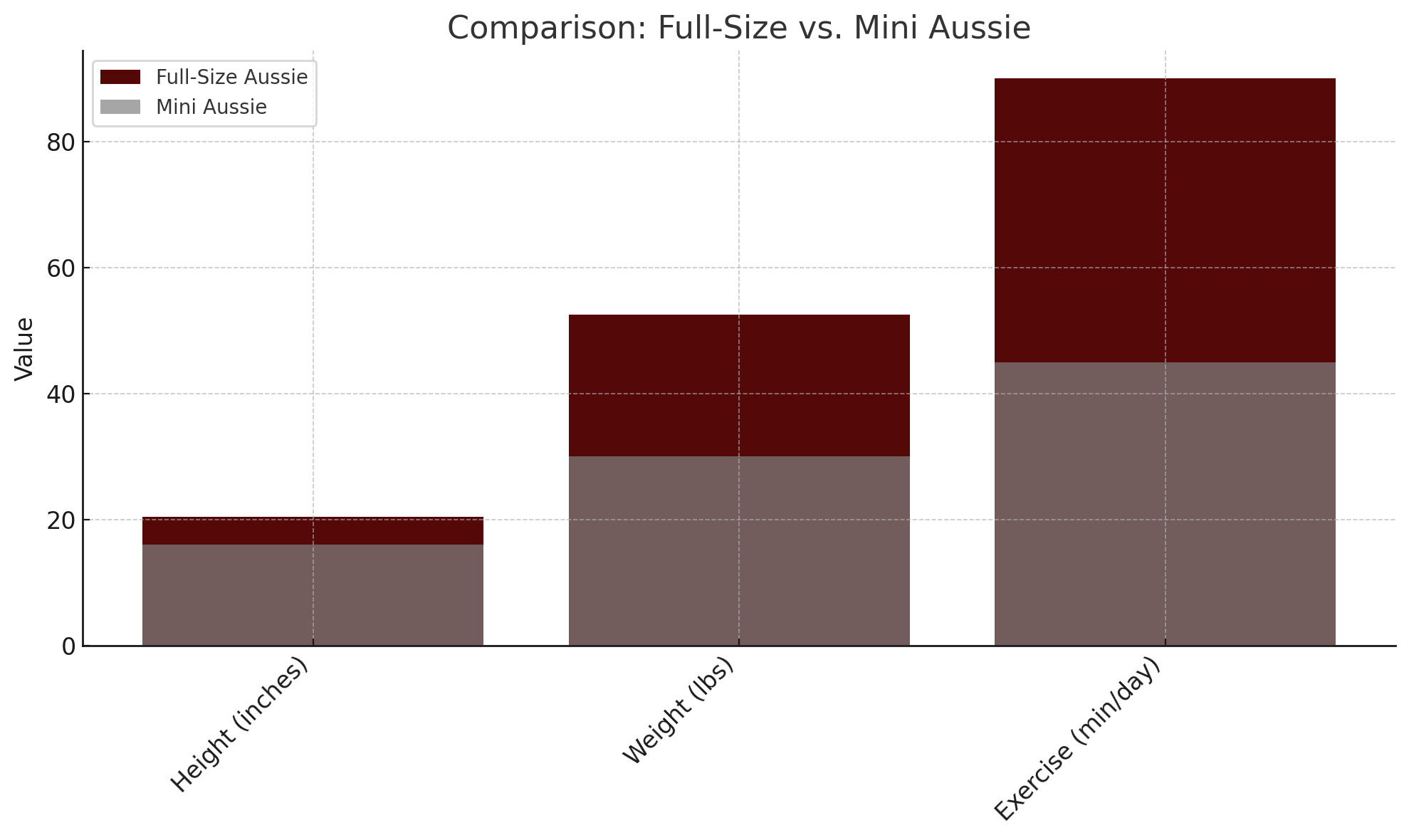Mini Aussie vs Full-Size Aussie: Which Fits Your Texas Lifestyle?
Here’s the deal: aussie puppies for sale are everywhere in Texas, but choosing between a mini aussie puppies for sale and a full-size Aussie can feel overwhelming. Whether you’re in a cramped Dallas townhouse or running cattle on a West Texas ranch, finding the right breed match is key. In this in-depth guide, we’ll walk through history, size, temperament, training needs, costs, and real-world Texas scenarios—so you can pick the perfect puppy for your life and landscape.
Breed Background & Origins
Full-Size Australian Shepherds have a history that’s as colorful and dynamic as their merle coats. Despite the “Australian” in their name, these dogs were refined primarily in the American West during the late 1800s. Ranchers and shepherds prized them for intelligence, agility, and unwavering herding instincts—traits vital for managing flocks across sprawling open ranges. Early records show Basque shepherds bringing a variety of herding dogs to California gold country; over successive generations, breeders selected for versatility, creating the foundation of the modern Aussie. By the mid-20th century, the breed’s reputation as a top-tier working dog was cemented, leading to its formal recognition by the American Kennel Club in 1991.
On top of that, the Australian Shepherd Club of America (ASCA) and the AKC both maintain detailed breed standards that outline desired traits—from coat texture and ear set to eye color and gait. Traditionally, Aussies were bred for function over form: powerful shoulders for long days on horseback, dense double coats to withstand sun and sudden mountain storms, and a boundless curiosity to adapt to any ranch task.
Here’s the deal… the modern Full-Size Aussie you see today still carries that working legacy. Colors range from blue merle to red tri, and genetics can even produce heterochromia (two different colored eyes), a hallmark of the breed’s striking look. Beyond ranch work, today’s Aussies excel in competitive dog sports—agility, obedience, flyball—or simply as devoted family companions.
Emergence of the Miniature American Shepherd
Fast forward to the 1960s and 70s, when ranchers and hobbyists began noticing naturally smaller Aussies on smaller properties. The miniaturization process wasn’t just about size—it required careful line-breeding to retain that same smart, hard-working temperament and structural soundness. Early pioneers documented bloodlines, tracked height and weight ratios, and prioritized hip and eye health to avoid common herding-dog issues.
By 2003, the Miniature American Shepherd had gained its own identity and was recognized by the United Kennel Club (UKC). In 2015, the AKC acknowledged Mini Aussies in its Herding group, cementing their status. These compact canines share the same colorful palette—blue merle, red merle, black, and red tri—but stand 4–5 inches shorter at shoulder height.
Real-World Insight: A Texas family with a quarter-acre backyard wanted the Aussie spirit but didn’t have room for the full-size version. After comparing bloodlines and lineage health reports, they welcomed a Mini Aussie, who quickly proved just as sharp on basic commands, sheep-herding simulations, and even backyard fetch sessions.
For more on breed standards and genetic health, dive into these resources:
Vet Explains Pets comparison - vetexplainspets.com
North American Herding Federation overview - nahf.org
Size & Space Requirements
Full-Size Aussie Dimensions
Height: 18–23 inches at the shoulder
Weight: 40–65 lbs
Ideal Space: 1+ acre; fenced yard
Mini Aussie Dimensions
Height: 14–18 inches at the shoulder
Weight: 20–40 lbs
Ideal Space: Townhome patio or small yard
Here’s the deal… if you’ve got a sprawling Hill Country ranch, a full-size Aussie can stretch out and burn off boundless energy. On the flip side, a mini Aussie comfortably navigates apartment hallways or suburban backyards without feeling cramped.
Comparison: Full-Size Vs. Mini Aussie
Temperament & Energy Levels
When it comes to personality and pep, both Aussies share a foundation of loyalty and smarts—but they channel that drive in different ways.
Here’s the deal… both Mini and Full-Size Aussies were born to work. Their herding instincts mean they love having a job—whether that’s rounding up sheep on a Texas ranch or fetching a ball in your backyard.
Herding Drive & Focus
Full-Size Aussie:
Intensity: Off-the-charts—needs complex tasks (agility courses, advanced obedience).
Focus Span: Long—can concentrate on a single activity for 30+ minutes.
Mini Aussie:
Intensity: High but more adaptable to shorter bursts of play.
Focus Span: Moderate—prefers variety and quick wins.
On top of that… both varieties excel at reading your body language. They’ll mirror your energy: if you’re calm, they’ll chill; ramped up, they’ll match your pace. This makes them perfect companions for active owners—but also means they pick up stress if left alone too long.
Social & Emotional Traits
Affection Level:
Full-Size Aussies often form one “person pack,” then warm up to everyone.
Mini Aussies tend to be social butterflies—quick to greet guests.
Separation Sensitivity:
Both can develop separation anxiety without early training; crate work and gradual departures help.
With Kids & Pets:
Their gentle natures make them fantastic with children and other animals—provided they’re socialized early and supervised during herding play.
“An Aussie without a job can turn their drive into mischievous energy—think digging or squeaky-toy demolitions.”
Matching Energy to Lifestyle
Full-Size Aussie: Best for homes with room to roam or owners who log miles running, biking, or hiking.
Mini Aussie: Perfect for busy families or retirees who enjoy daily dog-park visits and interactive puzzle toys at home.
Breed authorities estimate that a full-size Australian Shepherd can burn over 1,500 calories each day when engaged in sustained ranch work or competitive activities (Vet Explains Pets), whereas a Mini Aussie typically meets its energy needs—and stays happily occupied—with just 30–60 minutes of varied mental and physical enrichment daily (Dogster).
Training, Intelligence & Socialization
Both breeds are known as “smart cookies,” but there are nuances:
Learning Speed:
Mini Aussies often pick up commands faster—shorter attention spans mean quicker wins.
Full-size Aussies excel in advanced tasks but need consistent, engaging training.
Socialization & Puppy Culture:
Early exposure to varied people, sights, and sounds is crucial.
Check out our Texas Puppy Breeder Guide for step-by-step puppy culture protocols.
“A well-socialized Aussie, mini or full, adapts seamlessly to family, farm, or field.”
Here’s a quick list of training tips:
Use positive reinforcement—treats, praise, play
Keep sessions under 15 minutes for puppies
Introduce novel experiences gradually
Enroll in group classes by week 12
Health, Lifespan & Common Issues
Both breeds boast solid lifespans—12–15 years on average—but require proactive health screening:
ConcernFull-Size AussieMini AussieHip DysplasiaCommonLess commonEye Disorders (PRA, cataract)Regular testingRegular testingMDR1 Drug SensitivityYesYesExercise-Induced CollapseRareRare
Sources:
Vet Explains Pets breed comparison - vetexplainspets.com
North American Herding Federation - nahf.org
On top of that, mental stimulation—puzzle toys, scent games—prevents boredom-driven behaviors like chewing or barking.
Cost & Budget Considerations
Purchase Price
For current availability and pricing, please reach out to Ashber Farm—our team is happy to provide details and help you reserve your perfect Aussie. Contact us here.
Lifetime Costs (annual estimate):
Food & Treats: $500–$800
Vet Care & Preventatives: $600–$1,000
Training & Activities: $300–$600
American Shepherd puppies for sale in Texas can vary widely by lineage, color, and breeder reputation. At Ashber Farm, we maintain transparent pricing and include initial health checks, microchipping, and starter supplies. With over 20 years of breeding excellence, rigorous health testing, and a holistic puppy-culture approach, Ashber Farm truly stands at the top of the pack for quality. Explore our Aussie Litter and Mini Aussie Litter for current availability.
Texas Lifestyle Matchups
Urban & Suburban Living
Mini Aussie: Ideal for condos, townhomes, short yard runs
Full-Size Aussie: Needs daily dog-park visits, long hikes
Rural & Ranch Settings
Mini Aussie: Still enjoys open spaces but may herd smaller livestock or tackle agility
Full-Size Aussie: Perfect for cattle drives, large-scale herding, and boundary patrols
Here’s a real-world example:
On a recent trip to a family’s Hill Country ranch, we saw their full-size Aussie keep pace with ATVs all day—and still offer cuddles by the fire pit. Meanwhile, a downtown Austin couple reports their mini Aussie excels at fetch in a 400-sq-ft yard and joins them for paddle-boarding on Lake Travis.
Choosing the Right Fit: 5 Key Factors
Space Availability: Yard size, apartment vs. acreage
Activity Level: Daily exercise commitment
Training Goals: Basic obedience vs. performance sports
Budget: Purchase price and ongoing costs
Family Dynamics: Kids, other pets, visitor flow
Checklist:
Measure your yard
Log your weekly free-time hours
List family members’ ages/interests
Estimate budget (initial & annual)
Talk to a reputable breeder—start with Contact Us
Why Ashber Farm?
Our Promise of Quality, Health, and Community
With over 20 years of showing and breeding Australian Shepherds, Mini Aussies, and Bulldogs, Ashber Farm stands in a league of its own—and here’s why:
Deep Breed Expertise
We’re not a puppy mill or a big operation churning out litters. As a small, family-run breeder in Floresville, Texas, every decision we make centers on breed integrity and individual puppy well-being. Both of us have decades of experience in the AKC and ASCA rings, earning titles in conformation, herding, and obedience. That ring-tested expertise filters down to our breeding program—only the healthiest, most well-structured dogs earn a spot on our roster.
Quality Over Quantity
At Ashber Farm, we limit our breedings so each puppy gets personalized care and socialization. We perform comprehensive health screenings—hips, elbows, cardiac, eyes—and genetic panels on every parent dog to minimize inherited issues. From day one, our pups follow a holistic development plan: early neurological stimulation, supervised playgroups, and exposure to household environments. This level of care ensures your puppy isn’t just adorable but also confident, calm, and ready for real-world life.
Lifelong Support & Community
Here’s the deal: choosing an Ashber Farm puppy means you’re joining our extended family. We host puppy socials, training refreshers, and Q&A sessions—both virtual and on-site—so you never feel alone on your journey. Need guidance on crate training, nutrition, or tackling those first zoomies? We’re just a phone call or email away. Our commitment to you lasts well beyond the first two weeks.
Texas Roots & Family Values
We live and breathe this community. You’ll find us volunteering at local herding trials, sponsoring youth 4-H events, and donating to county fair charities. When you adopt from Ashber Farm, you’re supporting a breeder who gives back to Texas—and you’ll be invited to our annual “Ashber Family Reunion”, where puppies, alumni, and owners come together for fun, education, and fellowship.
Here’s the takeaway: when you choose Ashber Farm, you’re not just getting a puppy—you’re gaining a trusted partner, a wealth of expertise, and a vibrant community dedicated to helping your new companion thrive. Ready to learn more or reserve your pup? Contact us today and let’s start your journey together.
Next Steps
Choosing between a Mini Aussie and a Full-Size Aussie boils down to your space, schedule, and style. Both breeds bring loyalty, smarts, and energy to Texas homes—but one may fit your routine better. Ready to find your perfect puppy match? Read our free Texas Puppy Buyer’s Guide, explore our litters, or book a visit today.

